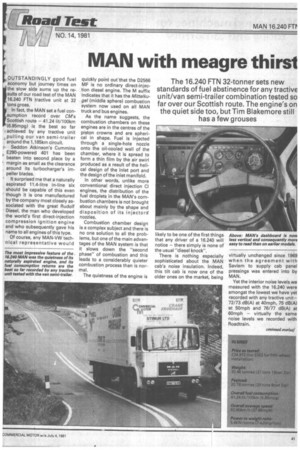MAN with meagre thirst
Page 29

If you've noticed an error in this article please click here to report it so we can fix it.
[OUTSTANDINGLY g9od fuel economy but journey times on
1 ' the slow side sums up the results of our road test of the MAN 16.240 FTN tractive unit at 32 tons gross. In fact, the MAN set a fuel con_sum ption record over CM's Scottish route — 41.24 lit/100km -(6.85mpg) is the best so far . achieved by any tractive unit i pulling our van semi-trailer ' around the 1,185km circuit.
i Seddon Atkinson's Cummins E290-powered 401 has been beaten into second place by a margin as small as the clearance around its turbocharger's impeller blades.
It surprised me theta naturally aspirated 11.4-litre in-line six should be capable of this even though it is one manufactured by the company most closely associated with the great Rudolf Diesel, the man who developed the world's first direct-injection compression ignition engine and who subsequently gave his name to all engines of this type.
Of course, any MAN-VW technical representative would
quickly point out that the D2566 MF is no ordinary direct-injection diesel engine. The M suffix indicates that it has the Mittelkugel (middle sphere) combustion system now used on all MAN truck and bus engines.
As the name suggests, the combustion chambers on these engines are in the centres of the piston crowns and are spherical in shape. Fuel is injected through a single-hole nozzle onto the oil-cooled wall of the chamber, where it is spread to form a thin film by the air swirl produced as a result of the helical design of the inlet port and the design of the inlet manifold.
In other words, unlike more conventional direct injection CI engines, the distribution of the fuel droplets in the MAN's combustion chambers is not brought about mainly by the shape and disposition of its injectors nozzles.
Combustion chamber design is a complex subject and there is no one solution to all the problems, but one of the main advantages of the MAN system is that it slows down the "second phase" of combustion and this leads to a considerably quieter combustion process than is normal.
The quietness of the engine is likely to be one of the first things that any driver of a 16.240 will notice — there simply is none of the usual "diesel knock".
There is nothing especially sophisticated about the MAN cab's noise insulation. Indeed, this tilt cab is now one of the older ones on the market, being virtually unchanged since 1969 when the agreement with Saviem to supply cab panel pressings was entered into by MAN.
Yet the interior noise levels we measured with the 16.240 were amongst the lowest we have yet recorded with any tractive unit72/73 dB(A) at 40mph, 75 dB(A) at 50mph and 76/77 dB(A) at 60mph — virtually the same noise levels we recorded with Roadtrain.












































